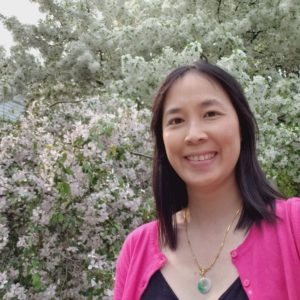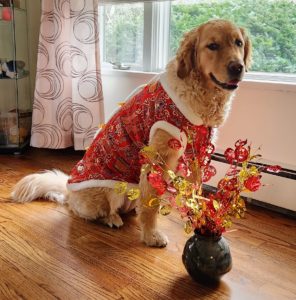Michael Otto
Designer Intelligence: Cut Weeks Off Test Fits and Help Landlords Lease Faster
What if you could help tenants right-size their space needs in minutes, test multiple layouts in hours, and riff on photorealistic finish schemes of your space in real time?
With lightning-fast programming tools, AI-assisted planning platforms, and next-gen image generation paired with talented design professionals, that’s no longer hypothetical—it’s happening now. For landlords and leasing teams, could this finally mean faster decision-making, less friction in the client experience, and accelerated revenue for building stakeholders?
The Leasing Bottleneck Everyone Gripes About
Even when a prospect loves your building, traditional space-planning can drag out the deal:
- Broker requests a test-fit
- The architect turns it in a week
- Tenant iterates—again and again
- Construction pricing follows weeks later
In a market where small-to-mid tenants want to move yesterday, this process kills invaluable momentum.
New Designer Tech You May Not Know About
As timelines tighten and tenant expectations rise, space planning must move faster—without sacrificing quality. By combining data-driven tools with expert insight, it’s now possible to evaluate more options earlier in the process.
NELSON designers use rule-based design engines to generate dozens of layout options in a fraction of the time. For one recent 28,000 SF program, we delivered four full-suite test-fits—complete with furniture blocks across different buildings—in just 48 hours (versus the typical two to three weeks). Before that, we validate space needs using nationally sourced NELSON data and planning ratios tailored to the tenant industry and location. Each plan auto-counts program elements, flags clearance and egress issues, and allows us to effortlessly toggle between layouts and adjacencies to better align with tenant goals.
Outputs flow directly into highly detailed BIM models, producing 3D visuals that are clear and actionable for users, contractors, and building teams alike.
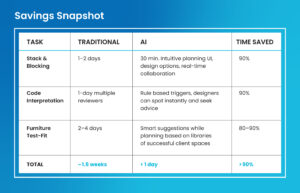
The Visual Sell: Image Gen and Rapid Mood Boards
Speed matters, but so does sizzle. Generative AI can create on-brand mood boards and hero shots fast. Our designers then fine-tune these assets into presentation-ready renderings that brokers can drop into Offering Memos the same afternoon.
- Pick from one of our pre-defined schemes or give us your best inspiration. Swap style references instantly; final images can be delivered the same day. Our AI tools are designed to produce visuals at a range of price points, and we continually refine them to better meet project needs.
- Tenants decide faster and with more confidence because they see exactly how their brand can live in the space, without overhyping and having to VE later.
People and AI: Why Designers Aren’t Going Anywhere
While headlines often warn of AI replacing human jobs, the real story is how it can elevate the expertise of skilled professionals—not replace them. Our in-house designers act as “pilots,” steering AI and other automations, validating code nuances, and layering local market intelligence that AI models alone often lack—like what fintech tenants in Chicago prefer versus biotech tenants in Raleigh.
The result is creativity amplified, not automated away. The burden of managing your design team lightens up for clients, which translates to a better tailoring of design solutions to meet tenant culture demands. Our designers enjoy a deeper focus on experiential amenities for your space and less time on the technical execution, just to simply communicate intent.
Real-World Impact: Four Deals, 11 Weeks Saved
The results speak for themselves—when AI is applied strategically, it can dramatically accelerate timelines and reduce friction without compromising quality.
Peak Performance – 400 k SF planned in 48 Hours
- A surprise vacancy needed traction fast. With our AI-driven planning engine, we delivered three tailored test-fits totaling almost 400K sq/ft in just 48 hours. One concept captured the prospect’s imagination so completely that they signed the lease with only minor tweaks.
Smarter Spend Equals Better Experience
- Keeping the existing walls felt “efficient,” but the layout fell short. Our live AI blocking tool ran instant cost-vs-benefit scenarios, proving that a light demolition and rebuild would elevate the user experience. The tenant happily paid the higher fit-out cost—and the landlord secured the deal.
From Plans to Pictures: The New Language of Design Intent
Here’s the bigger shift: in a visual-first medium like interior design, we’re moving beyond the limitations of words and 2D drawings. Instead, design intent is communicated through rapidly iterated, high-impact 3D visuals and curated presentations that everyone, from asset managers to tenants, can instantly understand.
This shift isn’t just aesthetic. It’s eliminating the back-and-forth that slows projects down, resulting in fewer misunderstandings, fewer revisions, and faster decision-making.
What is the new measure of a designer’s value? They can deeply understand your goals and then use today’s powerful digital tools to translate vision into visuals—quickly, clearly, and compellingly.
Building Resilient Infrastructure: A Guide for Government Buyers
As natural disasters become more frequent and intense, government buildings are increasingly at risk. From wildfires and hurricanes to floods and earthquakes, the stakes have never been higher for cities, counties, and states to ensure that their infrastructure is resilient and can continue serving the public in the face of these challenges.
The need for resilient architecture goes beyond environmental concerns—it’s a financial necessity too. The National Institute of Building Sciences highlights that every dollar spent on resilience saves $6 in future recovery costs. For government agencies, investing in disaster-resistant infrastructure is an opportunity to protect citizens and make long-term, cost-effective improvements to public buildings.
Tailored Solutions for Key Government Roles
Each government role plays a vital part in ensuring that buildings are not only resilient but also efficient and cost-effective. Here’s how different stakeholders can make a significant impact:
- Procurement Officers
Streamline purchases by working with pre-approved vendors specializing in resilient materials and use procurement frameworks that prioritize disaster preparedness. - Contracts Managers
Embed resilience clauses in contracts to ensure vendors meet sustainability and disaster resilience standards, with flexibility for future upgrades. - Government Buyers
Evaluate long-term savings with cost-benefit analysis tools to prioritize energy-efficient designs and adaptive reuse, demonstrating the value of resilience investments. - Supply Chain Directors
Focus on local sourcing and develop emergency procurement plans to ensure critical materials are readily available during crises. - Purchasing Managers
Use tiered pricing models and bulk purchasing options to provide scalable solutions for projects of all sizes, aligning with resilience goals.
Resilience Solutions for Key Government Sectors
Every government building faces its own set of challenges when it comes to resilience. Here’s a look at some of the specific needs for different sectors:
- Emergency Operations and Public Safety Buildings: Power outages, extreme weather, and the need for uninterrupted operations make these buildings a priority. Solutions include energy resilience (solar panels and battery storage), seismic retrofitting, and floodproofing measures like elevated foundations and flood barriers.
- Courthouses and Municipal Government Buildings: These buildings must maintain continuous operations, including judicial proceedings. Adaptive reuse of older buildings, smart technologies for real-time disaster response, and redundant systems (like backup power and data storage) are key to ensuring smooth operations during a crisis.
- Public Health Facilities and Emergency Shelters: These buildings often need to accommodate surges in demand during emergencies. Modular construction for adaptable spaces, reliable backup systems for water and HVAC, and repurposing non-essential buildings as shelters are solutions that can keep these facilities running smoothly.
Funding Opportunities to Support Resilience
Securing funding for resilience projects can be a challenge, but there are several programs available to help.
- FEMA’s Building Resilient Infrastructure and Communities (BRIC) program provides grants for pre-disaster mitigation, including flood protection and energy resilience projects.
- The Department of Energy (DOE) offers grants for energy solutions, such as solar panels, microgrids, and battery storage.
- The U.S. Department of Housing and Urban Development (HUD) provides grants through its Community Development Block Grant Disaster Recovery (CDBG-DR) program to support the construction of resilient municipal buildings.
The Future of Resilient Infrastructure
The future of resilient infrastructure is being shaped by emerging technologies. 3D printing, for instance, offers cost-effective, durable construction options that can be deployed quickly. Smart building systems, like automated flood detection and energy optimization, are transforming how buildings respond to emergencies. Modular construction continues to gain popularity as it allows for adaptable, scalable designs that can evolve with changing needs.
How to Get Started
If you’re ready to start building resilient infrastructure, the first step is conducting vulnerability assessments to identify which buildings are most at risk. Then, create a resilience roadmap to guide the integration of advanced technologies and smart solutions. Securing funding through grants and working with architectural experts will be crucial in moving your projects forward. From there, prioritize high-risk buildings and implement smart technologies for ongoing resilience monitoring.
Ready to take the next step?
Investing in resilient infrastructure today is an investment in the safety and future of our communities. By leveraging advanced solutions, securing funding, and aligning with the right stakeholders, government clients can create buildings that not only survive but thrive in the face of increasing natural disasters.
Contact us today to discuss how we can help you build a resilient infrastructure for your government buildings.
Terms and Conditions
Best of NeoCon 2023 Submissions Are Now Open
(Chicago, IL – March 1, 2023) NeoCon is pleased to announce that the submissions portal for the 2023 edition of the revered Best of NeoCon competition is now open. A NeoCon tradition since 1990, the competition garners hundreds of product entries each year as exhibitors vie for one of the coveted Best of NeoCon awards. Now in its 33rd year, the program will recognize superlative new products in 56 categories spanning a range of verticals including workplace, healthcare, hospitality, and education sectors. New for 2023, entries will be considered for a Business Impact Award, in addition to honors for Gold, Silver, Innovation, Sustainability, and the singular honor of Best of Competition.
“The Best of NeoCon finalists are emblematic of the latest trends and movements that are shaping how we work, gather, learn, and communicate. This year, I think we will see an even greater emphasis on solutions that consider the growing role that technology plays in our daily lives,” comments Best of NeoCon Director Eileen McMorrow. “From introductions that adapt easily and embrace emerging tech to those that prioritize ergonomics, our jurors will be seeking out solutions that streamline the rapidly evolving ways we work and live, inside and outside of the office.”
More than 50 new and returning jurors representing the industry’s leading design professionals, specifiers, facility managers and decision-makers, will gather on site at THE MART to thoroughly evaluate all Best of NeoCon entries in the days prior to NeoCon, June 12-14. Hailing from diverse backgrounds and areas of expertise, this year’s jury includes individuals from influential entities such as Honda, Cash App, NBBJ, and Studio GC. The final roster will be announced in April.
“I am thrilled to be returning as a Best of NeoCon juror this year. The early access and exposure to cutting-edge innovations and in-depth dialogue with exhibiting manufacturers of all sizes is an enriching and enlightening experience,” remarks Best of NeoCon 2022 Juror Chen-Hui Spicer, Regional Design Director, NELSON Worldwide. “This year, I’m especially looking forward to evaluating and recognizing products and solutions that prioritize human-centered design, sustainability, and adaptability.”
New this year, the Best of NeoCon jury will be able to nominate products for consideration for a Business Impact Award, which will recognize exceptional solutions through a business-oriented lens. These nominees will then be further evaluated by a group of discerning business journalists. The business jury will conduct in-person judging at THE MART on the Sunday before NeoCon, reviewing each of the nominated products based on the degree to which they contribute to a more successful business and better enterprise-oriented, built environment across verticals—from workplace to healthcare. Criteria include: aesthetics, adaptability, ergonomics, ESG, experience, productivity contribution, sustainability and tech-integration. The program is an evolution of last year’s inaugural Business Innovation Awards, which were a great success.
Heralding the first official day of NeoCon, all Best of NeoCon 2023 winners will be unveiled at a live ceremony at THE MART on Monday, June 12. Winning manufacturers will receive the recognizable award designed by NeoCon partner and renowned design firm Maiarelli Studio.
Exhibitors can submit entries through the Best of NeoCon online portal starting March 1, 2023. Any new products introduced to the U.S. market since June 2022 and that will be on display at NeoCon 2023 are eligible. Products that were entered in Best of NeoCon 2022 are not eligible. Submission deadlines and entry fees are as follows:
Early entry by April 21: $700.00
Regular entry by May 5: $800.00
Late entry by May 19: $900.00
More details on the program and entry process can be found at www.neocon.com/features/best-of-neocon.
NeoCon will take place June 12-14 at THE MART in Chicago. The show is open to trade, C-Suite executives, and other industry-related professionals and registration is free for all attendees. To register, head here. Stay tuned for more details on programming, product trends, and highlights ahead at NeoCon 2023!
For showroom, exhibitor, and general NeoCon news, images, and real-time information, follow NeoCon on: Facebook (@NeoConShows), Twitter (@NeoCon_Shows), Instagram (@NeoCon_Shows), and LinkedIn (@NeoCon-Shows).
Media Contacts: Novità Communications
Alexandra Zwicky / Danielle McWilliams / Emma Reuland / Katie Fosdick
# # #
About NeoCon: NeoCon is the world’s leading platform and most important event for the commercial interiors industry, held each year at THE MART in Chicago. Since launching in 1969, NeoCon has served as the annual gathering place for the commercial design world’s manufacturers, dealers, architects, designers, end-users, design organizations and media. The three-day event showcases game-changing products and services from close to 500 leading and emerging companies—providing unparalleled access to the latest and most innovative solutions. A robust educational program of keynote presentations and CEU sessions offers world-class expertise and insight about today’s most relevant topics as well as the future of commercial design. www.neocon.com
NeoCon® is a registered trademark of Merchandise Mart Properties Inc, a subsidiary of Vornado Realty Trust.
About THE MART: THE MART is the largest privately held commercial building in the United States: it encompasses 4.2 million gross square feet, spans two city blocks, rises 25 stories, and is visited by an average of 30,000 people each business day (or nearly 10 million people annually).
THE MART serves as the home to Chicago’s most creative and technologically innovative companies, including Motorola Mobility, 1871, Yelp, PayPal, and MATTER, as well as Fortune 500 companies Conagra Brands, Allstate, Medline Industries, Beam Suntory, Avant and Grainger. It is also the largest and most important center for design in North America with more than 250 premier design showrooms offering the latest resources for both residential and commercial markets.
IIDA GA Best Of The Best Award: Best Of Workplace
We are honored to share that Industrious Scottsdale received the Best Of Workplace Award by the 2021 IIDA GA Best Of The Best Awards. View the full list of winners here.
IIDA GA Best Of The Best Award: Best of Government, Institutional & Public Safety
We are honored to share that Passion City Church Cumberland received the Best of Government, Institutional & Public Safety Award by the 2021 IIDA GA Best Of The Best Awards. View the full list of winners here.
House Beautiful’s Guide to the Best Home Stores In America
Celebrating Asian American Heritage at NELSON
The 2023 theme for Asian American and Pacific Islander (AAPI) Heritage Month has been dubbed “Advancing Leaders Through Opportunity” by the Federal Asian Pacific American Council. Read more about a few of our own AAPI teammates as they share their stories around family, community, and their journey to NELSON. May is AAPI Heritage Month — and was because it marks two important events in Asian American history: the arrival of the first known Japanese immigrants in 1843 and the completion of the transcontinental railroad in 1869, which was built by Chinese immigrant workers. The AAPI umbrella term includes cultures from the entire Asian continent—including East, Southeast and South Asia—and the Pacific Islands of Melanesia, Micronesia and Polynesia.

Carey Ann Ragusa
Senior Technical Designer
—
How did you find your way to NELSON?
I found my way to NELSON through a recommendation by my good friend Schyler Yu. We had previously worked at a different firm together and have been friends ever since. When a position was available at NELSON, he suggested that I apply and felt that I was ready to move in a different path and upgrade my professional career. It was one of the best decisions I’ve ever made and thanks to Sky I wouldn’t have considered the move or be where I am now. NELSON has become a good home for me and has been very welcoming. Becoming part of the New York Asset Strategy team has been such an incredible journey and I honestly enjoy working with our team and our clients. There is a special connection we all have in New York.
How do you identify within the Asian American and Pacific Islander community?
I identify within the Asian American and Pacific Islander community as a first generation out of three siblings. My parents migrated to the United States from the Philippines to create better lives for themselves. My parents both met here in Long Island, got married, had three daughters and the rest is history. We grew up to two different dialects (Tagalog and Visayan) in my house. My dad who is 50% Chinese and 50% Filipino came from the city life in Manila and my mom who is 100% Filipino came from the Aklan province and lived in Kalibo. We grew with immediate family and secondary family with lots of family friends. We always had them around.
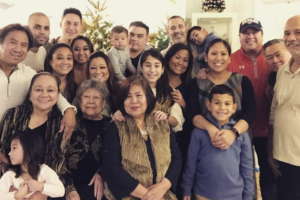
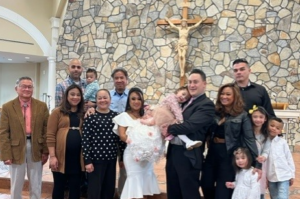
How has your heritage shaped the person you are today?
My heritage has shaped the person I am today through family values and morals I have retained from my upbringing at home. My parents, grandmother, and uncles all have shaped the way I think and have showed me what is important in life and culturally showed me the value of family, understanding the language when its spoken, working hard, and being grateful for what we have because there are many people that don’t get the same opportunity or items we have now.
In the Philippines, my parents had land to build on and requested that I design a building for them. The idea of designing a building in the Philippines helped me understand the culture, land surroundings, minor building codes that they barely have, the use of a ladder opposed to stairs and the scarce number of materials they use there. It was important for me to understand the process there and how it differed here in New York. This alone helped establish the person I am today culturally and made me realize what we have versus what we have there and how thankful and grateful we should be for even the little things and what we take for granted such as a roof over our head.
Does your family have any traditions that are especially important to you?
My family and I had very special traditions that we do and married to an Italian American I have incorporated that with our kids and life. Traditions are especially important to me. Although married to an Italian American, I’ve always looked to incorporate the traditions I was brought up with. Even when my husband was not my husband at that time, he embraced the Filipino culture and respectfully followed and learned our traditions. For special occasions in the Philippines men wear a barong and it is a clear see through flowery white/beige short or long sleeve button down. My dad had a special one made for my husband when he “went back home” so he can wear it along with all my uncles at weddings and other special occasions.
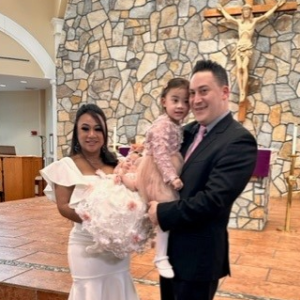
“Going back home” is a special term the Filipinos use when someone in the family is going back to the Philippines. That’s when the family purchases the special “balakbayan boxes (basically a 3’ wide x 5’ length x 2’ high shipping brown box) and we send chocolates, clothes, and various items in the United States that’s either not sold in the Philippines or too expensive to buy. In return they come back to the United States and always bring back items like handmade Ube or candies you don’t usually find in the United States.
Going back to traditions, most Filipinos are predominantly Catholic and my late grandmother would always have a special alter in the house dedicated to the Virgin Mary and have us pray the rosary along with her and would always ensure as a family we go to church on Sundays and we pray the rosary with her the rest of the week.
I got married in Disney and in the church, it was extremely important to me to follow a special wedding Filipino tradition of primary sponsors and secondary sponsors. The sponsors are all made up of special couples or single people in your life that has provided some kind of impact to your life who you respect and admire and look to being guided as the marriage grows. In addition there are four sets of secondary sponsors including Coin Sponsors, Veil Sponsors, Cord Sponsors and Candle. The secondary sponsors are more involved in presenting each item to the bride and groom. Each item is symbolic.
Catholic Coin Ceremony | The Arras
Exactly 13 Arras, or coins, are carried in a pouch and brought to the altar by the coin sponsors. The coins are an emblem of their future children and before the church, the bride and groom promise their care and love.
Catholic Veil Ceremony
Through the Catholic veil ceremony, two individuals are bonded and recognized as one. The veil sponsors drape one side of a white veil over the bride’s head and the other side over the groom’s shoulder as a symbol of unity. This also represents a wish for good health and protection during their life as husband and wife.
Catholic Cord Ceremony
Similar to The Veil Ceremony, the Yugal or infinity shaped cord is incorporated as a representation of the couple’s bond and union. Their sponsors will place the Yugal on top of the veil as the couple receives their blessing.
Catholic Candle Ceremony | Unity Candle
This is the final ritual symbolizing the bonding of two individuals and in Filipino culture, two families. The two outer candles are a representation of their individual lives before the wedding day. The candles exemplify all that the bride and groom are from their past experiences and represent each individual family. Together, the bride and groom will light the unity candle, blow out the single candles, and figuratively extinguish their past.
There are so many different Filipino traditions that are important to me, I can be here for a while describing the traditions I value . But before I end on Filipino traditions I value, one more tradition that I feel is extremely important and lands on birthdays. For every birthday, the family makes sure one dish is at least noodles that represent long life. It’s extremely symbolic and no matter what type of food is eaten during the birthdays, some type of long noodles need to be presented as part of the meal.
Who are the role models or mentors that have influenced you or helped guide you?
I have a few role models I look up to. One of my role models has always been my mother. As my grandmother raised me since I was 6 months, my mother worked two jobs to help and support the family. She has always been the epitome of resilience and a hard worker. She always taught me to work hard, strive to do better, never give up and always take care and respect your elders. As a Filipino taking care of your elders is a sign of respect. They provide the wisdom for the family. As a mother of two babies, I look to be at least half of what my mother is to me to my babies. I look to give them a life they can enjoy and embrace the Filipino culture by reading tagalog books, having my parents teach them the language and enjoying the Filipino flavors in food.
Two other role models I have that seem fitting to mention is an old colleague and friend in the architecture industry. They both taught me different ways of how to approach scenarios at a job site, what to look for in a drawing set, professionalism in all aspects of the job, the gives and takes in the industry, the balance of life and work, business is business, showing empathy is a good characteristic and not to be apologetic over everything. I valued the advice I received from both. They both hold a special place because without them I honestly don’t believe my career would’ve flourished as much as it has thus far and I’m so extremely gratefully for what they have shared and excited to embrace for what has yet to come and I mean that personally and professionally.
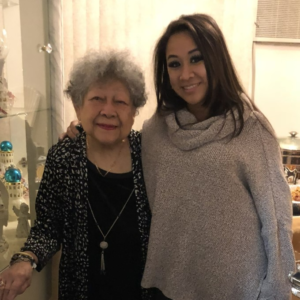
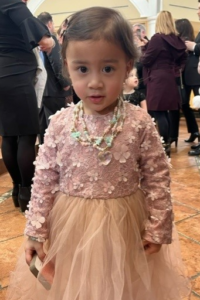
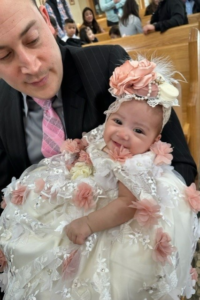
What brings you joy about your heritage and culture?
What brings me joy about my heritage and culture is the food. I enjoy the vast amount of food and dessert in the Filipino culture. We look forward to gatherings so we can have a taste of good cuisine aside from seeing all our relatives. Culturally we carry a lot of pork and fish in our dishes and even sometimes during bigger events we roast a pig on a stick. The Filipino food carries a variety of flavors. The secondary joy is spending time with my Tita’s and Tito’s and my cousins.
What does AAPI Heritage Month mean to you?
AAPI Heritage month means that it’s an opportunity for me to express the meaning of the Filipino culture and how the culture translates into my daily life. My culture impacts me daily especially when I come home. AAPI highlights the traditions people may not understand or be accustomed to and gives opportunity for different individuals to either try the food or think about visiting the Philippines. I will like to add since my mom is from The province Boracay is an incredible place to visit.

Keo Ballerstein
Design Leader
—
How did you find your way to NELSON?
I joined NELSON five years ago and was promoted to Design Leader | Director during my tenure. NELSON has been a great place for me to harness my creative energy to design places for people to connect.
I started my career in architecture & design, focusing on affordable housing and public projects. But over my 20 years in the industry, I gradually transitioned to Workplace. While each had their unique requirements, the underlining principle is to build communities where people can connect. I strongly believe that design can be socially impactful and bring us together.
How do you identify within the Asian American and Pacific Islander community?
I am an American of Lao descent.
I was born in Laos and raised in America. My parents immigrated the family to America following the Vietnam War. My earliest memories are from living in America. Sadly, I do not have any recollection of my birthplace. Navigating the different cultures at a very young age brought-on some challenges, but I never felt a need to replace one for the other. My heritage is an imperfect blend of American and Lao traditions and customs.
Who are the role models or mentors that have influenced you or helped guide you?
My parents are my role models.
My mother was a talented textile weaver of Lao silk who had other talents in traditional Lao arts and crafts. Most things she created and owned were purposeful, and her attention to detail and care for her craft have influenced how I approach design.
My father was an educator in Laos and one of the founders of the Lao America Association of Florida, serving as its first president. He was an eloquent communicator and leader, and I am inspired by the way he was able to warmly connect with so many people.
It has been about 10 years since their passing, and while their stories have yet to be told, they continue to influence the person I am today.
What brings you joy about your heritage and culture?
Great question. It brings me joy when I see friends or strangers of a different ethnicity respectfully embrace my culture. It is one of the reasons why I fell in love with my husband. To see him enjoy Lao food, his willingness to blend American customs with Lao customs, or to understand when he speaks Lao in his most American accent, that brings me joy.
What does AAPI Heritage Month mean to you?
Asian American and Pacific Islander Heritage Month recognizes the contributions and influences of the AAPI community in the United States. It can be daunting to think that the various AAPI ethnicities are all lumped into this one community, but I hope the month of May provides a platform for each AAPI ethnicity to share their unique stories. It is important that we dispel mainstream stereotypes of the AAPI community, and for the community to continue their contribution to American history.
Chelsea Cheng
Senior Project Manager
—
How did you find your way to NELSON?
I came to NELSON after I had my second maternity leave. I was hired by one of my managers at my very first job. I left NELSON after five years and returned after another five. I just celebrated my 3rd year return anniversary.
How do you identify within the Asian American and Pacific Islander community?
I was born and raised in Hong Kong. While waiting for our immigration application to be approved, I came to study at a boarding school in Vermont when I was 15. My family then moved to Bayside, New York the following year and I have been in New York ever since.
How has your heritage shaped the person you are today?
Having a different heritage allows me to keep my mind open. It comes natural to me to acknowledge things from different cultures, from different angles and allow myself to really try to understand, “see” and appreciate new and unfamiliar things.
Does your family have any traditions that are especially important to you?
My family has been in the U.S. for over 30 years now. We still celebrate Chinese New Year and most Chinese holidays including Mid-Autumn Festival. During Chinese New Year, we will dress in red or in traditional influenced clothing made with traditional fabric and patterns. Here is Poncho, our three-year-old Golden Retriever, dressed in doggy clothes made with traditional Chinese fabric. We also display decorations in red/gold.
Who are the role models or mentors that have influenced you or helped guide you?
My first project manager. As a new college graduate, he let me attend meetings and go to job sites by myself. It allowed me to make and learn from my mistakes; but most importantly it allowed me to gain experience and confidence. I was not only in a production role; I was being shaped to be a project manager since day one. I was given the chance to prove myself and I wish to do the same to all junior staff members.
What brings you joy about your heritage and culture?
When people ask questions and try to understand and show interest of where I came from and how different Hong Kong is from China or the rest of the Asian countries. How different each of our dialect is, etc.
What does AAPI Heritage Month mean to you
Every day is Heritage Day for me. Having a specific month honoring our heritage just a bigger reminder to appreciate where we come from, where our roots are, and where our fundamental beliefs begin.
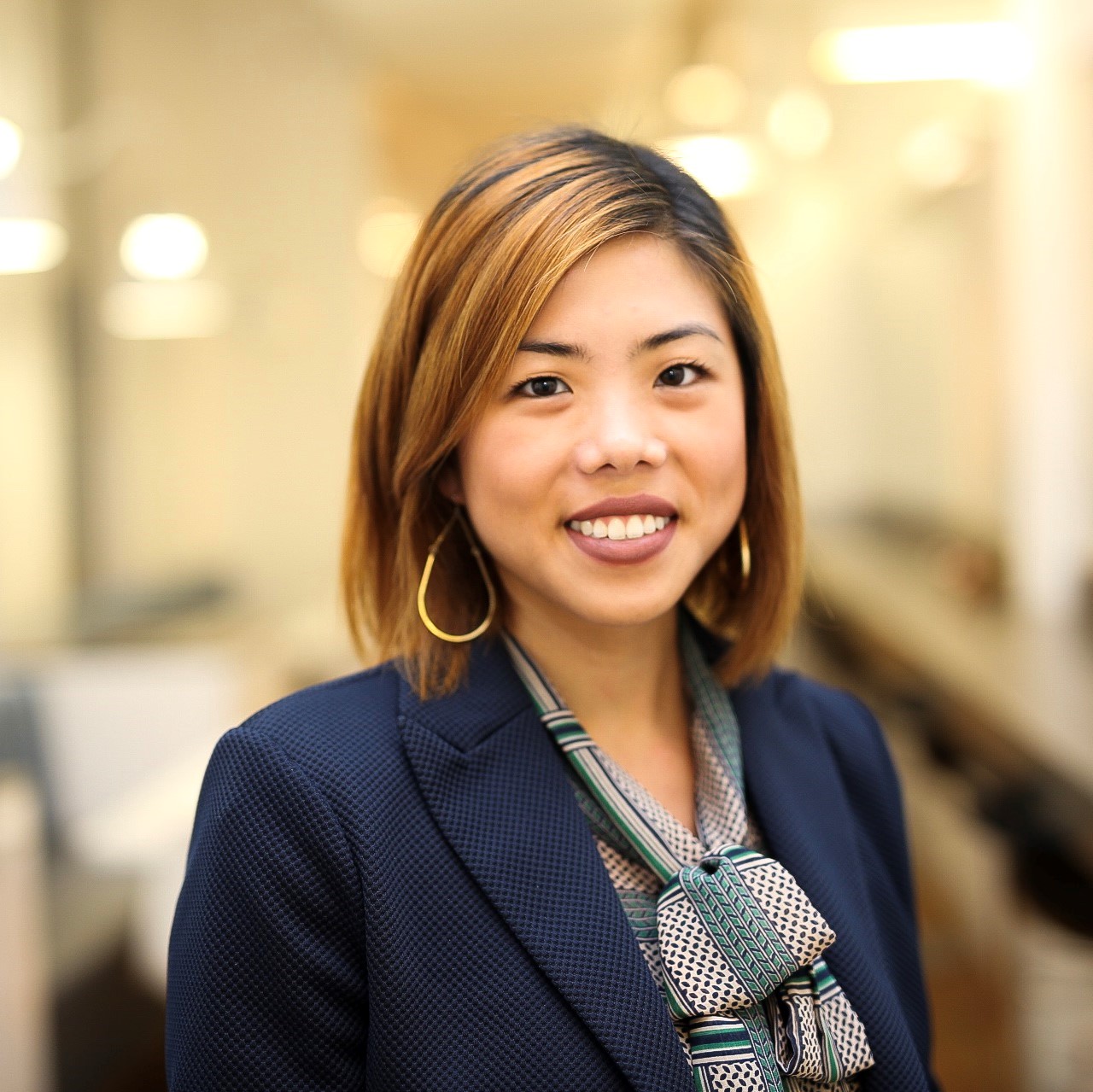
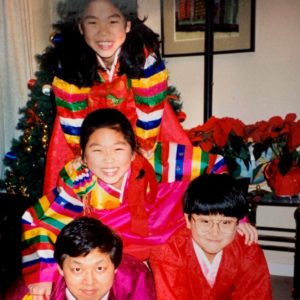
Monica Jun
Senior Project Manager
—
How did you find your way to NELSON?
I moved from my hometown, Chicago, nine years ago to NYC and The Mufson Partnership through a recruiter. They were merged with NELSON shortly after.
How do you identify within the Asian American and Pacific Islander community?
I identify as Korean-American. When people ask me where I’m from, I tell them I’m from Chicago (wait for pause) and my parents immigrated from Seoul, South Korea. It’s important to me that I provide context because although AAPIs may have similarities in our stories, they still have unique characteristics that are more identifiable within each subset. Being specific about my background usually sparks better conversation.
How has your heritage shaped the person you are today?
It is interwoven into every aspect of my life whether it’s accepted, rejected, or remixed as my own. There are aspects of Korean culture that I don’t integrate, and even that is an intentional reaction to the culture. Whenever I go to Seoul, I go on a mini shopping spree because my body shape is a better fit with theirs. Something as simple as finding clothes that fit me is 100 times easier to do in South Korea. However, when I was younger, the fashion sense for girls/women was much more modest and feminine there than what I was drawn towards given my American 90s culture of baggy jeans, baby tees, and starter jackets. I intentionally rejected these “girly” sensibilities because it did not align with my feminist ideals. It shaped my personality at a formative age to be the opposite of what I saw; bold (not meek), loud (not demure), strong (not sensitive). Those qualities are (and were) incorrect stereotypes, but I had not yet understood the layers of cultural nuance and history to be able to appreciate it like I can today. It took me until my thirties to start to wear pink without any guilt.
Does your family have any traditions that are especially important to you?
FOOD! My culture revolves around food. Eating is a communal and social engagement. Parents who grow up in a war-torn country don’t always express affection outwardly in the way I was used to seeing it in TV and movies growing up. But when my mom would make traditional meals to commemorate certain milestones, it was her way of expressing her love. Traditional Korean food can take a long time to make (lots of side dishes requiring pickling, marinading, hard to find ingredients). There is an expression “Let’s eat until we die” that is used jokingly when you are with loved ones and so happy to be eating good food together.
I also love celebrating New Years. My family did our Korean traditions on January 1, instead of Lunar New Year as our own blend. It’s time where we eat traditional food, play traditional games, dress up in our hanboks (see photo), and honor our parents. I loved it as a kid (because you get $$$) but the rituals around it always grounded us in our Korean heritage.
Who are the role models or mentors that have influenced you or helped guide you?
My mom is my primary role model. She sacrificed a lot for the wellbeing of my family and does it so willingly. She’s taught me what’s truly important in life and to reject a situation that goes against my fundamental core values. She can also connect with any stranger on the street. Her effortless ability to make meaningful human connections has always been an inspiration.
Professionally, Joe Schirripa is my mentor 😊. Joe has helped me navigate how to get my voice to be heard and perceived in intentional ways. It’s one thing to voice an opinion, but another to persuade others. I find this invaluable especially when I’m the minority at the table. He’s also insisted that I have a seat at the table. By empowering me, I know how to better empower others.
What brings you joy about your heritage and culture?
It’s encouraging to see the global community embrace South Korean pop culture and food. There are aspects of K-pop and Korean TV dramas I never thought Americans would embrace so I get a kick out of seeing so many teenagers knowing their lyrics without fully understanding what they’re saying but loving the vibe.
What does AAPI Heritage Month mean to you?
It’s a time to learn more about the different cultures under the giant umbrella that is AAPI. A time to celebrate the various cultures. Although it is such a behemoth, I appreciate the efforts being made to make it as inclusive as possible.
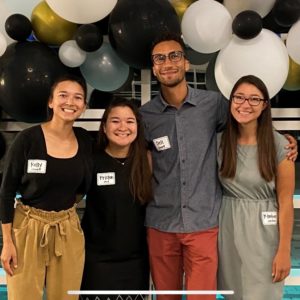
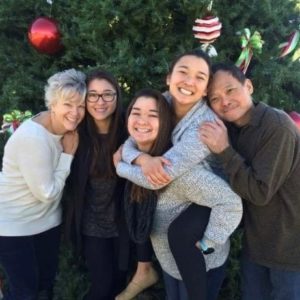
Kimberly Moy
Recruiter
—
How did you find your way to NELSON?
I met Maria in my first interview! She was awesome and I thought if I could work with someone so happy and good at their job, that seemed like a good place to be.
How do you identify within the Asian American and Pacific Islander community?
My father is Chinese, his parents immigrated to America shortly before he was born. They were really proud to be in America, worked for many years in a manufacturing facility, assimilated to the community as best they could, my grandma taught herself English, and they raised my dad and his siblings very “Americanized” so to speak. They lived near Chinatown in Chicago for several years and kept many Chinese and traditions and superstitions. My grandma passed many of those onto me and my sisters.
How has your heritage shaped the person you are today?
It gives me another perspective. Seeing the hard work my grandparents put in to give my dad and his siblings the best life possible has shaped my values and how I see others. My mother’s heritage is Polish/German, so growing up in a mixed family and seeing/living the different cultures has changed how I see myself and how I relate to others.
Does your family have any traditions that are especially important to you?
Hong Baos (this is a joke 😊)! It’s a little red envelope with money inside. Traditionally given by grandparents or elders at times of celebration for good luck and good fortune…but who doesn’t like the tradition of receiving money from our grandparents? In more seriousness, any holiday and birthday are always important and fun to celebrate.
Who are the role models or mentors that have influenced you or helped guide you?
My whole family, but especially my parents. This has become more and more true as I grow older and realize all that they have done and overcome.
What brings you joy about your heritage and culture?
The emphasis on being together and getting to know my grandparents and aunts and uncles has always been a joy. Like it is with all cultures, celebrating holidays and partaking in traditions is particularly joyful.
What does AAPI Heritage Month mean to you?
It is a way to embrace diversity and a reminder to reflect on our heritage and what shapes us into who we are.
Creating Space(s) For All: A Guide to Creating Inclusive & Inspiring Work Environments
Studies have proven that a huge part of making employees feel comfortable, safe, and productive has to do with their environment. Knowing this, how can employers and designers use the return to the office as an opportunity to bring a more empathetic perspective to the workplace?
In this insight report, NELSON Worldwide has established five key principles in making more inclusive and inspiring workspaces for all.
